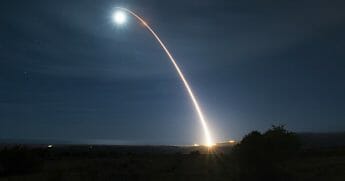
A new, advanced Chinese weapon has caught the U.S. flat-footed, according to a new report.
In August, China tested a hypersonic nuclear-capable missile that left one source saying, “We have no idea how they did this,” according to the Financial Times, which did not disclose the names of its sources.
The test went like this: China launched a rocket carrying what is known as a hypersonic glide vehicle. The missile circled the earth in a low orbit toward its target, which it missed by roughly 25 miles.
Hypersonic vehicles travel at Mach 5 or faster.
The report from the Financial Times said the test reveal China “was far more advanced than U.S. officials realized. The test has raised new questions about why the U.S. often underestimated China’s military modernization.”
The test came weeks before Air Force Secretary Frank Kendall warned that China now had the “potential for global strikes . . . from space.”
Writing about the Chinese advance on The Drive, Tyler Rogoway tried to explain the danger, saying that a hypersonic glide vehicle, as tested by China, “could make a very long maneuvering flight through the atmosphere at very high speeds to its target.”
The concept has the “potential to bypass not just missile defenses, but even many early warning capabilities,” he wrote, adding that “range limitations also become a non-factor and the timing of an inbound strike is also far less predictable.”
Taylor Fravel, an expert on Chinese nuclear weapons policy and professor at the Massachusetts Institute of Technology, told the Financial Times that the weapons would allow China, which is not a party to any arms limit treaties, to bypass missile defense systems.
“Hypersonic glide vehicles . . . fly at lower trajectories and can maneuver in flight, which makes them hard to track and destroy,” said Fravel.
In August, General Glen VanHerck, head of North American Aerospace Defense Command, said China had “recently demonstrated very advanced hypersonic glide vehicle capabilities,” according to the Financial Times.
New Chines weaponry would “provide significant challenges to my NORAD capability to provide threat warning and attack assessment,” he stated.
Without commenting directly on the test, the Pentagon signaled it is worried about China.
“We have made clear our concerns about the military capabilities China continues to pursue, capabilities that only increase tensions in the region and beyond,” said John Kirby, the spokesman for the Department of Defense. “That is one reason why we hold China as our number one pacing challenge.”
A 2020 report in Science pictures the U.S. well behind the curve after years of stops and starts into hypersonic weapons.
“You see a flurry of activity, a lot of investment, and then we conclude it’s a bridge too far,” explained aerospace engineer Mark Lewis, director of defense research and engineering for modernization at the Department of Defense.
The report said the U.S. is “largely defenseless against such weapons, at least for now, in part because it can’t track them.”
Thomas Karako, director of the Missile Defense Project at the Center for Strategic & International Studies, said the Pentagon is working on solutions.
“Unstoppable today does not mean unstoppable tomorrow,” said Shari Feth, a materials engineer at the U.S. Missile Defense Agency.
“There are technologies that could be developed that could be used for a more robust defense,” Feth continued. “But we have more work to do to get there.”
